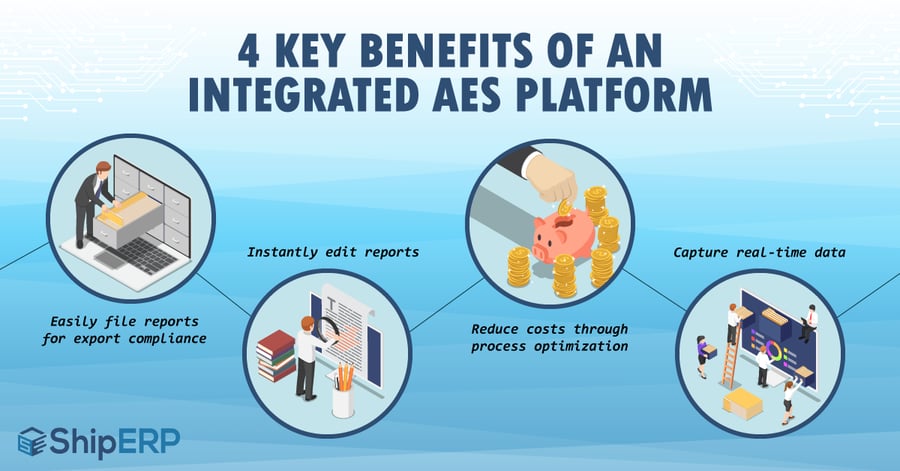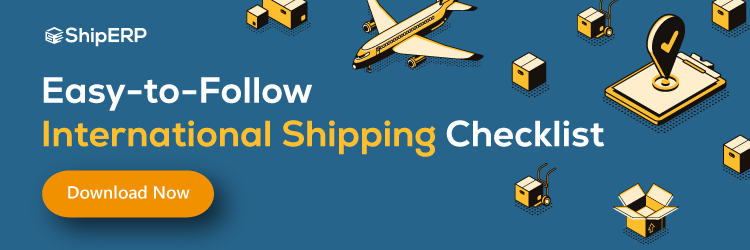
4 Key Benefits of Using an AES Integrated Platform
Automated Export Systems (AES) solve several issues with export compliance—instant feedback and transaction confirmation, flexibility in editing, and an increase in cost savings are just a few among them. Learn how using AES can make your compliance process faster.
Automated Export Systems (AES) were designed and implemented to resolve pain points in export and shipping. These pain points include slow processing, frustrating reporting and report alteration, and additional costs to ship goods internationally. With that said, AES-integrated platforms communicate with the government-level AES to resolve these issues without weighing users down with extraneous information.
Reliable Export Compliance
When you are shipping goods into countries as numerous as the goods you offer, worrying about physical paperwork should be the last thing on your mind. Automated Export Systems place filings directly with the federal government and any other international databases necessary to export goods from one country to another.
AES is part of a broader automation push from the Department of Homeland Security (DHS) to reduce barriers to business for domestic operations. Furthermore, the Automated Commercial Environment (ACE) consists of modules such as the Electronic Data Interface (EDI) and Automated Broker Interface (ABI), as well as the AES.
Instant Editing Makes Compliance a Primary Focus
Compliance managers can change their requests constantly at virtually every step of the process. Because compliance managers can change information at any time, they can process data rapidly, while any mistakes or omissions are likely to be caught at the filing stage by AES systems.
International Trade Agreement Compliance Made Simple
Part of operating on the global scale is utilizing trade agreements and reaping the benefits they offer. Some smaller businesses that participate in exports may struggle with NAFTA or GATT compliance if they don’t use AES or AES-supporting platforms. Also, businesses should know which actions start the 60-day NAFTA clock for providing evidence of duty of payment to another NAFTA country.
Easily Make Report Alterations
When you need to change your export reports, filing amended reports and mailing them in just won’t cut it. Having a platform which interfaces with the AES systems for governments is a vital aspect of operations on a global scale because export compliance will vary between jurisdictions, but the platform will help ensure all boxes are checked and necessary information is present.
Fix Errors On The Fly
When the AES systems notify businesses of an error in processing a request, the user can make updates directly through the AES. Having a platform which can be used to integrate with AES streamlines this process by monitoring orders and requests. Errors include both incorrect data inputs and omissions.
Expedite Shipping With Reduced Costs
When waiting is reduced due to shorter review times, massively small data entry requirements, and fewer staff on hand for filing meet workplace efficiency, there is only one way for shipping costs to respond—by becoming cheaper. Before there were integrations built on platforms with AES, requests had to be processed through the Census Bureau’s AESDirect system.
For goods valued at more than $2,500, an Electronic Export Information (EEI) filing is required. This filing provides both export data and export control, for use by the government in determining important economic health metrics, such as Gross Domestic Product (GDP).

Expedited Shipping Through Process Optimization
Not only is shipping substantially cheaper than it once was, shipping costs
have been optimized in a way which has also sped up the shipping and export processes. Ways that turnaround time and costs for exports have improved include:
- Reduced duplicate paperwork - AES adoption minimizes the number of paper-to-electronic—and vice-versa—changeovers.
- Instant export and shipping updates - Change management is a common need within the export realm. Until AES adoption, forms had to be completely resubmitted, reanalyzed, and reapproved. Now, forms can be reuploaded and rechecked on the spot, as many times as needed.
- Immediate ITN verification - As soon as a request is placed within AES, the transaction is assigned an ITN number which propagates through the AES system and its associated partner systems.
Paper documentation and paper review are incredibly costly when considering the time required to turn them from physical to electronic records, time wasted on waiting, and time spent waiting on documents and information to reach both the Commerce Department’s Bureau of Industry and Security, as well as the State Department’s Directorate of Defense Trade Controls.
Once records have landed with these regulators, they are evaluated and distributed to partner agencies. Approvals can be received instantly through AES partner platforms.
With AES and AES-supporting platforms, licenses and records can be sent, reviewed, and authorized on the spot.
Cost Reduction Through Process Optimization
Optimizing the export process cuts through numerous layers of red tape. Less red tape means less time required to file, analyze, and process each shipping request. Less time spent on these operations, combined with automated request analysis and instant update access to all reports an organization’s customers have filed, have reduced export costs by millions of dollars per year for some organizations once all of their customers have gotten onto an AES platform.
When picking an AES partner, businesses can consider an SAP-based option due to the massive number of secure, built-in integrations that SAP and its partner network offers.
Keep Your Finger On The Pulse With Real-time Data
When you need to know what your market wants, do not seek data from the outside. SAP-enabled AES lets businesses retain access to their shipping information. By monitoring shipping and export information continuously, businesses can predict changes in supply and demand throughout entire months, sometimes years.
Benefits Beyond the Business
Not only can future trends benefit the companies that generated the information, export statistics can help companies and governments predict trends in demand and establish benchmarks for economic benchmarks such as Gross Domestic Product (GDP).
Insights into data from different parts of the export process, such as billing and invoicing documentation, shipment data, delivery time tracking, and other parts of the export process can further improve the export process.
For help on your AES optimization, reach out to us! We help our clients with automation and efficiency in their business processes. We are especially helpful with shipping and compliance in the context of SAP ERP integrations for our enterprise clients.



